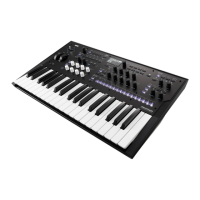Filter
38
Gain
[High, Normal]
This is available only when Type is MS-20 LPF, MS-20 HPF, or Polysix.
Normal provides the resonance character of a typical analog 4-pole filter.
High creates a more pronounced resonance.
Crossfade
[0…100]
This is available only when Type is Multi Filter. Crossfade morphs between the Mode 1 and Mode 2 settings. 0 is all
Mode 1, 100 is all Mode 2, and 1-99 are intermediate values between the two Modes.
Trim
[0…100]
This adjusts the volume level at the input to the filter. If you notice that the sound is distorting, especially with high
Resonance settings, you can turn the level down here.
Out (Output Level)
[0…100]
This controls the output level of the filter.
Multi Filter
This page is available only when the Filter page Type is set to Multi Filter.
What’s a Multi Filter?
Standard multimode filters generate low-pass, high-pass, and band-pass filters simultaneously—but only let you use
one of them at a time. The Multi Filter gives you access to all three filter modes simultaneously, in any combination,
along with the dry input signal. You can choose from a large number of preset combinations, or create your own
complex filter modes using the Manual controls.
This is capable of some cool sounds in and of itself, but things really get interesting when you use Crossfade (see
“Crossfade” on page 38). Crossfade allows you to mix between two of these filter settings (Mode 1 and Mode 2), using
modulation sources such as envelopes, LFOs, or real-time controllers.
1 (Mode 1)
[List of filter types]
This sets the filter type for Mode 1.
LPF, HPF, BPF, and Band Reject are the standard filter types. For more information, see “Filter,” on page 36.
LP+BP, LP-BP, LP-HP, BP+HP, BP-HP, Dry+LP, Dry-LP, Dry+BP, Dry-BP, Dry+LP-HP, Dry+LP-BP, Dry+BP-LP,
Dry+BP-HP, Dry+HP-LP, Dry+HP-BP, LP+HP+BP: These combine two or more filters at equal volumes. Dry is the
un-filtered input signal. The minus sign (“-”) indicates when the phase of a filter is reversed.
All On uses the Low Pass, High Pass, Band Pass, and Dry signals at equal volumes.
Manual lets you create your own mix of the filters; an additional four parameters will appear. For more information,
see “Manual,” below.
2 (Mode 2)
Mode 2 has the same selections as Mode 1.

